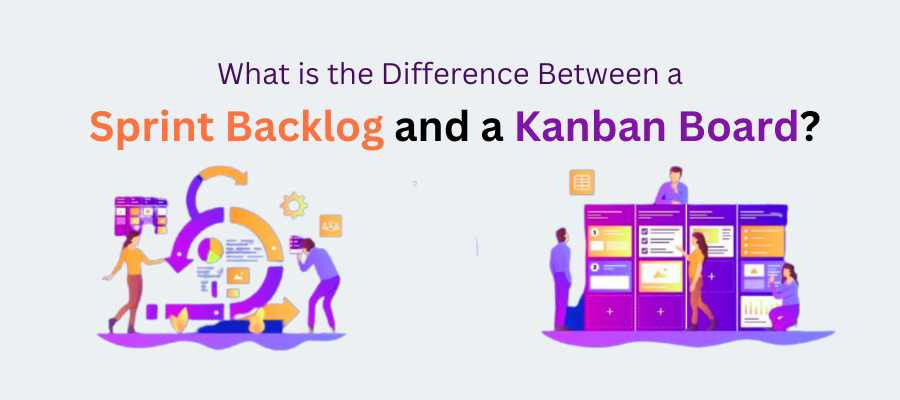Difference Between a Sprint Backlog and a Kanban Board?

Sprint Backlog and Kanban Board look similar from afar. This explains why some Agile teams will use the two terms interchangeably. But, although they are both scheduling systems in Agile, they are not the same thing.
The end goal is mostly the same for the two systems – create a clear workflow to help keep the team on track for maximum productivity.
If you run an Agile team, the chances are you use either Kanban Boards or Sprint Backlogs often. You may also already use both, but it is essential to stop and understand their differences. This allows you to choose the system that serves your Agile team best.
What is a Sprint Backlog?
A Sprint Backlog is simply a list of the work items an Agile Team intends to accomplish during a particular Sprint. The items are typically arranged by order of priority. The product leaders are tasked with ensuring they are completed in the specified order.
Items added to a Sprint Backlog are generated from the Product Backlog when the Sprint is in the planning phase. The backlog will also include the plan the team intends to use to deliver the product increment to realize the Sprint.
A proper Sprint Backlog is vital for eliminating common Sprint problems such as scope creep. It helps by ensuring everyone on the teams knows what they should be working on at any particular time during the Sprint.
What is a Kanban Board?
A Kanban Board is a workflow visualization tool. It can be either physical or digital, and its primary purpose is to bring some clarity to the work process. The Kanban Board also helps limit the work in progress to ensure maximum efficiency.
The principle behind Kanban Boards is to allow all the members of an Agile team to see what they have already finished, what is in progress, and what is upcoming.
Kanban Boards are easy to use and highly versatile. Although they were initially used in the manufacturing sector, their versatility makes them suitable for any industry and even for use by individuals that want to keep track of personal work.
Sprint Backlog vs. Kanban Board: Key Differences Between the Two
1. Continuous vs. Iterative
One of the key differences between Kanban Board and Sprint backlog is work organization. Kanban is continuous and will emphasize workflow. In this system, the work flows continuously and is interrupted as the process does not end. There are just different streams of work that flow toward completion and will do so continually.
With Sprint Backlog, the process is iterative, and the tasks to be accomplished are organized into sprints. The sprints have clear cycles with a specific starting point and end. A typical Sprint cycle lasts between 2 and 4 weeks. Once a Sprint is complete, a retrospective is conducted, and the findings are used to make the next Sprint more efficient.
2. Structure
Sprint Backlog is part of a Scrum Board. The Scrum Board also includes a Product Backlog. Items in the Sprint Backlog will come from the standard or product backlog.
A Kanban Board is a complete scheduling system in the Agile framework and not just a part of another system or board.
3. Setup
At the beginning of every Sprint, new items must be added to the Scrum Board, creating the Sprint Backlog. But, with a Kanban Board, the tasks will flow infinitely as the work process is ever-looping and repetitive. Some teams often find this framework dull and boring.
4. Ownership
A Sprint Backlog is owned by the small Sprint team tasked with working on the items included in the list. Hence a large project can have several small teams, each working on its own Sprint Backlog. A Kanban Board is owned by the entire department or even the company. Just one Kanban Board can be enough for multiple teams in an Agile framework.
Sprint Backlog | Kanban Board | |
| Work Organization | Iterative cycles | Continuous flow |
| Structure | Part of a Scrum Board | A full scheduling system |
| Setup | New items are added at the start of every Sprint | Tasks flow infinitely |
| Ownership | One sprint team | Whole company or an entire department |
Which One Should You Use?
The main choice will be whether to use a Kanban Board or Scrum Board since Sprint Backlog is part of the latter. The best way to decide which works best for your organization is to try both.
The choice between the two also depends on your experience level in the Agile framework, project types, and what you think will be easy for your organization to adapt.
That said, Scrum Board and hence the Sprint Backlog is ideal when starting with Agile and when you want a well-defined rhythm. Kanban Board is perfect if you prefer more flexibility, as there is no waiting for Sprint Planning or Review and when working on more predictable and repetitive tasks.
References
- https://nulab.com/learn/project-management/kanban-vs-scrum-boards-whats-the-difference/
- https://www.forecast.app/blog/scrum-board-vs-kanban-board
- https://www.parabol.co/blog/kanban-vs-scrum/



